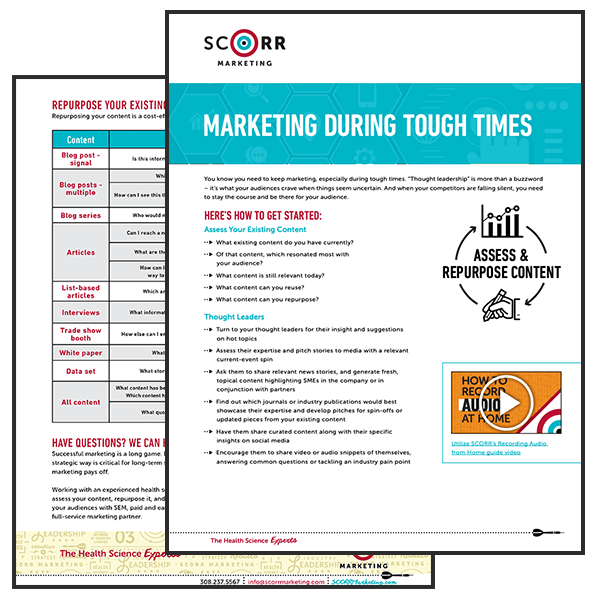It’s a marketing case study that has practically passed into legend: During the Depression, cereal manufacturer Post took the conservative course of action. They cut back on marketing spend, pulled back on advertising, and settled in to wait it out until the economy rebounded. It was a knee-jerk response to a major economic downturn.
Their rival, Kellogg’s, took another approach entirely. They doubled their ad budget and plunged into radio advertising, promoting their new cereal, Rice Krispies, hard. While Post cereals disappeared from consumers’ line of vision during a time when the entire country was collectively struggling, Kellogg’s was riding alongside consumers, front of mind. Kellogg’s was the brand consumers turned to. And when the economic fog lifted, not only was Kellogg’s the brand that was on everyone’s breakfast table — their profits had risen almost thirty percent. During the Depression! Post never regained dominance.
Kellogg’s isn’t the only company that gained traction during tough times. Walt Disney and Tollhouse both launched during the Depression, creating memorable brands that have endured for generations. In the 2001 recession, the iPod launched to great success. And more recently, during the recession a decade ago, Amazon focused on innovation, launching its Kindle and growing sales by almost thirty percent. Groupon filled a need for cost-cutting consumers and businesses, launching in 2008 and rapidly gaining traction.
It isn’t just a B2C phenomenon. In fact, in a study of 600 B2B companies, McGraw-Hill Research found, those who maintained or increased ad spend during the 1981–82 recession saw compelling results. They averaged higher sales growth than those who pulled back — and what’s more, their growth continued. Three years later, those companies’ sales had increased a whopping 256% over those who had cut back on advertising.
You don’t need a major product launch to rise to the top during tough times. As “noise level” drops when competitors cut back on advertising, if you simply remain consistent, present, and vocal, you’ll not only stay front of mind, but you’ll project the image of corporate stability that reassures your audience during challenging times. And an increase in share of voice — as others fall silent — can ultimately equate to an increase in share of market … along with an increase in profits.
Admittedly, it’s more of a challenge for B2Bs to maneuver in tough economic times — especially when much of business comes from in-person trade shows that have been curtailed because of COVID-19. But the principle remains the same. The bottom line: Investing in marketing now can seize market share that lasts long after an economic downturn ends.
Naturally, in clinical research, it’s critical to stay active for more than business purposes. COVID-19 may be disrupting life around the entire globe, but it’s not pausing the needs of the patients who desperately need clinical research to continue. For every car commercial with up-swelling music and voice actors speaking in hushed and reverent tones, assuring you they’re still here for you … those patient populations who are still waiting for treatments, cures, vaccines, and hope don’t need a car dealer in their corner — they really do need you to be there for them. Continuing to be present, and to strengthen your presence for them, is paramount.
Marketing Strategies During a Recession
So how do you continue to market your brand while staying cost-conscious? It comes down to finding the balance between cutting costs to survive today, while investing in your business to grow tomorrow:
- Maintain your marketing. As tempting as it is to cut advertising and marketing spend, this is not the time to do that — you need to be the brand that endures and improves market share while your competitors are cutting back and fading into silence.
- Align with trends. Multiple reports show online news, social media, and app usage is up as employees around the world work from home. Even when the COVID-19 crisis is over, moves to digital may slide back some, but some of those habits will remain, increasing overall digital dependence. Adapt to your audience by utilizing paid search, paid social media, retargeting ads, and other online tactics to not only take advantage of current behavior, but to be well positioned for the continued trends moving forward.
- Use innovative tactics. While COVID-19 has eliminated in-person events, fortunately, technology has enabled virtual options like virtual trade show booths where you can still actively engage your audience.
- Refocus your marketing investments on the areas of highest ROI and growth; turn to your metrics to show you the way.
- Focus on your existing customers. You’ll reassure them that you have staying power, remain front of mind, and create loyalty that will extend into the future. Listen to what they’re saying, now more than ever, and respond the way they need you to. After all, marketing is not about trumpeting your products far and loud; it’s about listening to your audience’s true needs — and giving them what they’re asking for.
- Lean on content marketing. Hopefully, even before this, you’ve been building up brand awareness, thought leadership, and brand loyalty through content marketing — sharing your knowledgeable insights in an authentic, engaging way. So what happens when you’ve built up that coveted audience … and then you stop producing the content they’ve come to rely on you for? What happens when you disappear? Especially during tough times? Don’t fail your audience. Remain steady and present.
- Grow the top of the funnel. While your audience may not be as quick to spend now, they will still be assessing their next steps. Give them information with solid content marketing so when they are ready to resume business, you are who they turn to.

Not sure exactly how to start?
Download our worksheet to guide you to cost-effective content marketing, as one way to continue engagement.
